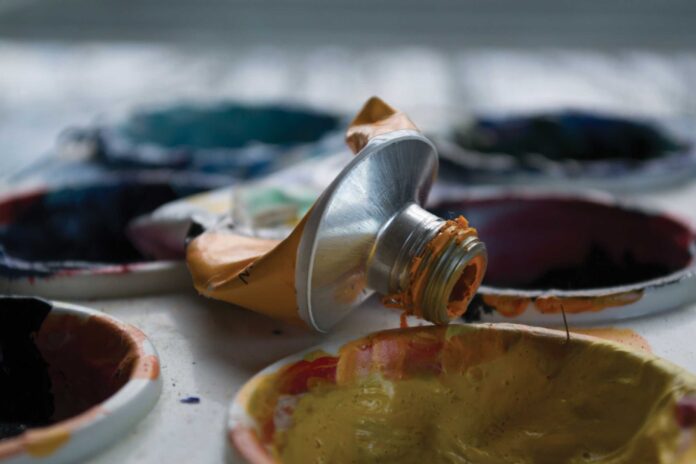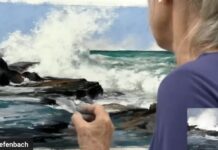Learn to decipher the codes, names, and symbols printed on your paint tube labels, and discover what they mean for you and what you’re trying to achieve in your work.
By Daniel Grant
Pop quiz: What’s in that tube of oil paint you’re using? Well, there’s oil — linseed probably, although it could also be poppy seed, safflower, sunflower, walnut, or something else — and pigment, which is a ground-up organic or inorganic mineral. Anything else? The answer almost always is yes, but you likely won’t be told that by the manufacturer because it’s proprietary information, a trade secret.
“I don’t share my recipes,” says Robert Gamblin, president of the Oregon-based Gamblin Colors.
So, what can you learn from the information manufacturers do reveal on their paint tubes’ labels or the boxes they come in?
Color Name and Number
At present, most manufacturers tell you the name of the color, as well as its scientific numeric designation, corresponding to a standardized Color Index, a nine-volume reference that is jointly produced by the Society of Dyers and Colourists in England and the American Association of Textile Chemists and Colorists in the United States.
For instance, the color index number for cobalt blue is PB28 (P for pigment, B for blue, then the assigned number), while cadmium red is PR 108. Nothing is ever simple, however, and some manufacturers use the Munsell system of color specification. The label for Liquitex’s cadmium red medium, for instance, says “Munsell 6.3 R” (the R refers to the shift to red).
Durability (Or Lightfastness)
Most manufacturers also describe the durability (or lightfastness) of their paints on the product labels. The American Society of Testing and Materials rates pigments I, II, or III for their resistance to fading in daylight, or lightfastness, with I being the most resistant. Liquitex follows the ASTM format in its lightfastness ratings, but Van Gogh’s ratings are +++ and ++, with +++ being the highest degree of lightfastness and ++ what the company calls “normal degree of lightfastness.” Rembrandt lists lightfastness, starting with the most permanent, as A, B, C, and D. Winsor & Newton has two different rating systems, ++++, +++, ++, and +, and AA, A, B, and C (++++ and AA are the most lightfast).
Health and Safety Information
While it’s optional for manufacturers to include the paint’s durability, as well as its color index name and number, health and safety information is required on the product label. Since 1990, the federal Labeling of Hazardous Art Materials Act (an amendment to the Federal Hazardous Substances Act) requires that all art materials sold in the United States be reviewed to determine the potential for causing a chronic hazard, and that appropriate warning labels be included on those products.
To that end, manufacturers must include a statement (such as “Conforms to ASTM D-4236”) that ensures the manufacturers submitted their product formulas to a board-certified toxicologist for review. The toxicologist determines what labeling is required under the standard. Also required is a telephone number in the United States from which additional information may be obtained.
There are a number of board-certified toxicologists working with art materials companies. Many companies subscribe to the labeling program of the Boston-based Arts and Creative Materials Institute and place “AP Nontoxic,” “CP Nontoxic,” and “Health Label” seals on the labels of their paints.
Both “AP” and “CP” indicate that the Institute certifies the products are safe even for children (“AP” specifically refers to nontoxicity, while “CP” includes both nontoxicity and performance requirements), and “Health Label” signifies that the warning label on the product has been certified by an ACMI toxicologist, and, if hazards are found, appropriate warnings appear on the label. After review, the Institute’s toxicologist may allow the product to carry one of its seals. Note: very small tubes of paint are exempt from most of this required federal labeling.
What Is Not Listed
Among the ingredients that are not indicated on the tube or the box it came in are stabilizers (between 1 and 2 percent by volume) used to keep the pigment adhered to the binder; dryers (less than 1 percent by volume) to ensure that the paint surface dries within days rather than months; and extenders (up to 10 percent by volume), which improve the texture and consistency of the product.
Student-grade paints, such as Winsor & Newton’s Winton range or Royal Talens’ Van Gogh, have even higher percentages of undisclosed additives, such as toners, preservatives, and fillers, as well as substitute pigments for the more expensive cadmiums and cobalts, among others (see “A Word About Substitutes”).
Why It Matters
Knowing what is in a tube of paint, and the differences between one company’s paint and another’s is, of course, not just an academic pursuit for artists. At times, false assumptions come into play. Does a higher price mean better paint, for instance? Not necessarily, since products made in Europe and elsewhere have greater transportation costs and an import tax, all of which adds another 10-20 percent to the price.
Some artists also equate tinting strength with better-quality pigments, but the fact is that manufacturers may buy a less expensive grade of cobalt and add a phthalo blue to it in order to bring the tinting strength back up.
There are no parallels in the art supply field to makeup counters where one can try out cosmetics or dealerships where one might test drive a car. There is no Consumer Reports for artist colors, in which researchers have examined how smooth or stiff a paint is, how it holds up in direct sunlight, how luminous the color is, or how it mixes with other colors. As a result, artists must seek information about paints from other artists they know or from the manufacturers.
Where to Learn More
“Artists call up with questions” all the time, according to Marcia Babler, a former technical consultant at the Grumbacher division of Sanford Corporation in Oak Brook, Illinois. Like Grumbacher, many makers of art supplies have technical support staff available by telephone or online communications to assist artists. And many of these people are, like Babler, artists themselves who have extensive experience with both the products made by those companies and those made by others.
Paint makers also provide technical information on how to use their products and sometimes offer safety-in-the-studio advice on their websites. Of course, the technical support staff — artists or not — are going to represent their company in a favorable light, and trade secrets stay secret.
For this reason, other artists’ opinions may actually be more revealing, since what ultimately distinguishes one paint from another is not an absolute scale of quality, but personal preference. Some artists like their paints creamy, while others are more inclined to a stiffer texture — and the ingredients that make each possible are unlisted and undisclosed. In addition, some paint suppliers grind their pigments more finely than others, which may affect the color’s luminosity and how light is refracted, but you won’t find that information on a paint tube label either.
So what difference do all those trade secrets matter in the final analysis? Perhaps not much. As Babler notes, most artists’ paint boxes contain a variety of makers’ colors — with some tubes possibly picked up for the very unaesthetic reason of price — and those paints are usually mixed with others on a palette. In this way, all those differences in formulas, so scientifically or lovingly arrived at by their makers, become moot.
A Word About Substitutes
If you’re looking to buy a tube of cadmium red or cobalt blue, but those aren’t available or cost more than you want to spend, you may want to consider less expensive alternatives, known as hues. Here’s what you need to know: the usual hue of cadmium red is called napthol or thioindigold red, while the alternatives for cobalt may be ultramarine (itself a synthetically produced pigment), indanthrene blue, phthalocyanine blue, or something called pigment blue 60. Lemon yellow is another pigment that has traditionally been composed of barium yellow but now is found to be nickel titanate; and alizarin crimson turns out to be an unpronounceable dihydroxyanthraquinone.
Test Before You Invest
Note that some art supply shops, distributors, and manufacturers offer free or inexpensive sample packs of paints and papers for prospective customers.
***
DANIEL GRANT is the author of The Business of Being an Artist and several other career guides for artists. A former faculty member of Lyme Academy College of Fine Arts, he writes for a variety of print and online publications.
PleinAir™ magazine is focused on landscape paintings by historical and contemporary artists, art collections, events, and the process of creating plein air paintings. Beautifully designed with rich reproductions on high-quality paper, PleinAir features the top artists and artworks from around the world. Start your subscription here!
And browse more free articles here at OutdoorPainter.com




